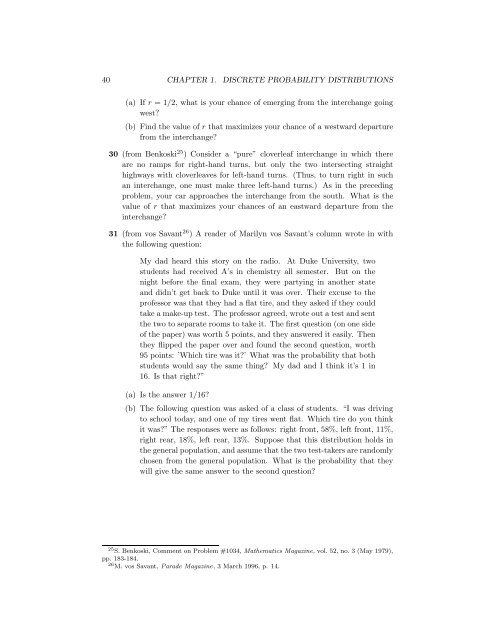Chapter 1 Discrete Probability Distributions - DIM
Chapter 1 Discrete Probability Distributions - DIM
Chapter 1 Discrete Probability Distributions - DIM
- No tags were found...
Create successful ePaper yourself
Turn your PDF publications into a flip-book with our unique Google optimized e-Paper software.
40 CHAPTER 1. DISCRETE PROBABILITY DISTRIBUTIONS(a) If r =1/2, what is your chance of emerging from the interchange goingwest?(b) Find the value of r that maximizes your chance of a westward departurefrom the interchange?30 (from Benkoski 25 ) Consider a “pure” cloverleaf interchange in which thereare no ramps for right-hand turns, but only the two intersecting straighthighways with cloverleaves for left-hand turns. (Thus, to turn right in suchan interchange, one must make three left-hand turns.) As in the precedingproblem, your car approaches the interchange from the south. What is thevalue of r that maximizes your chances of an eastward departure from theinterchange?31 (from vos Savant 26 ) A reader of Marilyn vos Savant’s column wrote in withthe following question:My dad heard this story on the radio. At Duke University, twostudents had received A’s in chemistry all semester. But on thenight before the final exam, they were partying in another stateand didn’t get back to Duke until it was over. Their excuse to theprofessor was that they had a flat tire, and they asked if they couldtake a make-up test. The professor agreed, wrote out a test and sentthe two to separate rooms to take it. The first question (on one sideof the paper) was worth 5 points, and they answered it easily. Thenthey flipped the paper over and found the second question, worth95 points: ’Which tire was it?’ What was the probability that bothstudents would say the same thing? My dad and I think it’s 1 in16. Is that right?”(a) Is the answer 1/16?(b) The following question was asked of a class of students. “I was drivingto school today, and one of my tires went flat. Which tire do you thinkit was?” The responses were as follows: right front, 58%, left front, 11%,right rear, 18%, left rear, 13%. Suppose that this distribution holds inthe general population, and assume that the two test-takers are randomlychosen from the general population. What is the probability that theywill give the same answer to the second question?25 S. Benkoski, Comment on Problem #1034, Mathematics Magazine, vol. 52, no. 3 (May 1979),pp. 183-184.26 M. vos Savant, Parade Magazine, 3 March 1996, p. 14.
















